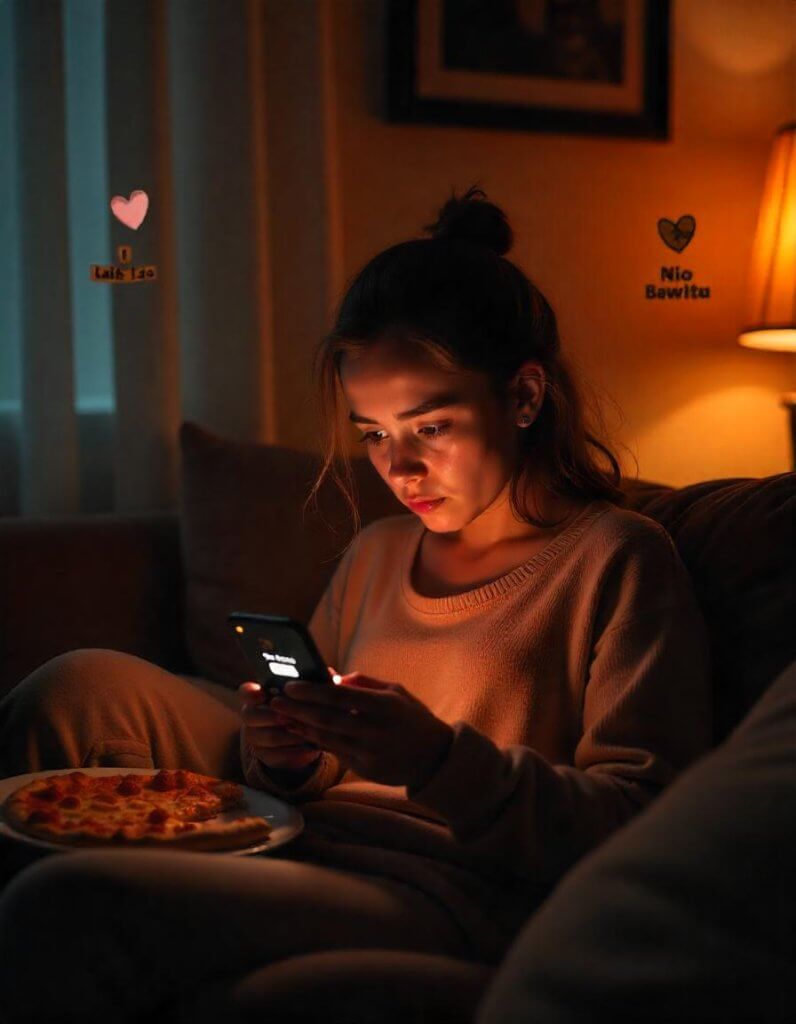Онлайн-знайомства зблизили людей більше, ніж будь-коли, але вони також змінили те, як ми говоримо і пишемо. Від смайликів до коротких форм - світ знайомств розробив свою власну мову. Незалежно від того, новачок ви чи досвідчений учасник цифрових романів, розуміння найновіших абревіатур сленгу знайомств є обов'язковим. Ці швидкі коди та фрази заощаджують час і роблять спілкування легким та швидким. Але що вони всі означають? Давайте розберемося, щоб переконатися, що ваше наступне повідомлення буде зрозумілим, веселим і кокетливим.
Що таке сленгові абревіатури для знайомств і чому вони важливі?
Сленг знайомств, абревіатури та акроніми стали частиною нашого спілкування. Коли люди знайомляться в додатках, вони не хочуть писати довгі речення. Замість цього вони використовують короткі коди, які швидко передають суть. Це можуть бути абревіатури для знайомств, наприклад, "LTR" - "довготривалі стосунки" або "ONS" - "секс на одну ніч".
Ці абревіатури - більше, ніж просто скорочення. Вони сигналізують про наміри, тон і стиль. Знаючи їх, ви зможете краще розуміти інших і виражати свої думки. Уявіть, що ви отримуєте повідомлення з написом "DTF?" або "NSA" - не розуміючи, що вони означають, ви можете щось пропустити або заплутатися. Вільне володіння цією сучасною мовою зараз є частиною звичайного досвіду онлайн-знайомств.
Популярні абревіатури для знайомств, які потрібно знати
Ось деякі поширені скорочення, які ви можете зустріти в профілях або повідомленнях на сайтах знайомств:
- АНБ - Без жодних зобов'язань
- LTR - Довгострокові відносини
- ONS - "Секс на одну ніч
- FWB - Друзі з перевагами
- DTR - Визначте стосунки
- ICYMI - На випадок, якщо ви пропустили
- TDTM - Занадто глибоко, занадто багато
- BDE - Велика енергія
- DTF - До... ну, ви зрозуміли.
- SMH - Я хитаю головою.
Ці абревіатури допомагають людям висловити те, чого вони хочуть. Наприклад, той, хто пише "тільки ЛТР", швидше за все, не зацікавлений у випадковому сексуальному досвіді. Якщо хтось згадує FWB, він може шукати дружбу з можливістю більшого, але без серйозних зобов'язань.
Справжнє значення ONS та стенду в знайомствах
Термін "ONS" розшифровується як "секс на одну ніч". Це одна з найпоширеніших і найвідоміших абревіатур знайомств. Люди використовують його, щоб висловити короткочасний інтерес - зазвичай фізичний і без емоційних зобов'язань. Ви також можете зустріти слово "стенд", яке використовується в цьому контексті, як "просто випадковий зв'язок".
Стенд може бути цікавим, але ясність є ключовим фактором. Переконайтеся, що обидві сторони розуміють один одного. Хтось може написати "відкритий до нових знайомств" або "не шукаю зараз ніяких стосунків" у своїй біографії або першому повідомленні. Інші можуть написати щось на кшталт "без друзів, шукаю ЛТР", щоб показати свої уподобання.
Розуміння того, як вживаються слова stand та ons, допоможе вам уникнути плутанини та непорозумінь. Ці терміни можуть з'являтися в середині повідомлень або у вашій відповіді, якщо ви прямо говорите про те, чого хочете.
Скорочення та абревіатури, що використовуються в профілях знайомств
Більшість профілів на сайтах знайомств короткі і по суті. Люди використовують абревіатури, щоб вкласти всю свою енергетику в кілька слів. Деякі з них зрозумілі і поширені, тоді як для вивчення інших може знадобитися час.
Ось кілька поширених прикладів:
- GSOH - Гарне почуття гумору
- SFW - Безпечно для роботи
- NSFW - Небезпечно для роботи
- ISO - У пошуках
- HWP - Зріст Вага Пропорційний
- BBW - Велика красива жінка.
- BHM - Великий красень
- YOLO - Живеш лише раз.
Ви можете побачити повідомлення з написом "ISO FWB, GSOH обов'язково". Це може означати, що людина шукає випадкові зв'язки з кимось, з ким весело і легко спілкуватися. В іншому профілі може бути написано "Тільки ЛТР, ніяких зустрічей", що чітко вказує на обмеження і цілі.
Читаючи ці профілі, зверніть увагу на те, як розміщені ці абревіатури. Вони допомагають відфільтрувати людей, які не відповідають вашим настроям або бажанням. У цьому і полягає принадність абревіатур у знайомствах - вони спрощують пошук.
Ярлики повідомлень, які ви побачите в онлайн-чатах
Додатки для знайомств побудовані на повідомленнях. І більшість людей не хочуть набирати довгі абзаци. Ось тут і вступають у гру ярлики на основі повідомлень. Від кокетливих вступних повідомлень до серйозних повідомлень про реєстрацію - ось кілька корисних стилів повідомлень, з якими ви можете зіткнутися:
- HMU - Підійди до мене.
- СДМ - Що ти робиш?
- BRB - Я зараз повернуся.
- LOL. - Смійтеся вголос
- IDK - Я не знаю.
- IYKKYK - Якщо ти знаєш, то знаєш.
- ILY / ILU - Я кохаю тебе.
- TMI - Забагато інформації
Хтось може надіслати вам повідомлення на кшталт: "HMU пізніше?" або "BRB, йду за кавою ☕". Це робить розмову легкою та невимушеною. Ви також можете зустріти жартівливе використання терміну "ons" у потоках повідомлень, особливо коли люди прямолінійні, але стримані щодо того, чого вони хочуть. Культура абревіатур допомагає рухатися вперед.
Коли варто використовувати скорочення, а коли їх уникати
Абревіатури корисні, але якщо їх використовувати занадто багато, це може заплутати когось або виглядати як лінь. Використовуйте їх, коли вони додають ясності, особливо при формулюванні цілей знайомства. Наприклад, написавши "LTR, no ons", ви швидко визначитеся зі своїми цілями. Але заповнювати свою біографію купою випадкових букв? Це - ні.
Важливо також підбирати тон повідомлення відповідно до ситуації. Якщо у вас з кимось серйозні стосунки, оминайте абревіатури і кажіть, що ви відчуваєте. Але якщо ви просто фліртуєте або спілкуєтесь у додатку для знайомств, кинути коротеньке "LOL" або "BRB" може бути весело.
Коротше кажучи, використовуйте абревіатури з розумом. Знайте свою аудиторію і поважайте її стиль спілкування. І пам'ятайте - іноді повне речення може сказати більше, ніж абревіатура для знайомств.
Чи отримуєте ви повідомлення? Як спілкуватися чітко
Значна частина успішних онлайн-знайомств полягає в тому, щоб знати, як відправити правильне повідомлення. Незалежно від того, чи говорите ви про почуття, чи про встановлення кордонів, комунікація - це все. Багато людей віддають перевагу чітким повідомленням, а не заплутаній суміші сленгу та коротких форм.
Але не хвилюйтеся - як тільки ви вивчите поширені абревіатури знайомств, ваша впевненість у собі зросте. Ви знатимете, що насправді означає повідомлення на кшталт "DTF сьогодні ввечері?". Або ви зрозумієте, коли хтось скаже: "Тільки LTR - ніяких "он", ніякої драми". Це не просто листи. Це справжні інструменти для побудови вашої історії знайомств.
Тож наступного разу, коли хтось надішле вам пряме повідомлення із запитанням "СДМ?" - ви будете готові.
Висновок
Сленгові абревіатури для знайомств змінили те, як ми спілкуємося, фліртуємо та знаходимо кохання онлайн. Від абревіатур для знайомств до коротких, лаконічних повідомлень - мова кохання стала цифровою. Спочатку ці терміни можуть здатися незрозумілими, але з невеликою практикою вони стають другою натурою. Незалежно від того, чи уникаєте ви стійки, чи шукаєте партнера, чи просто сподіваєтесь, що ваше повідомлення помітять, розуміння цього сленгу допоможе вам залишатися на крок попереду у світі сучасного роману. Спілкування - це ключ до успіху, і тепер у вас є мова для цього.













